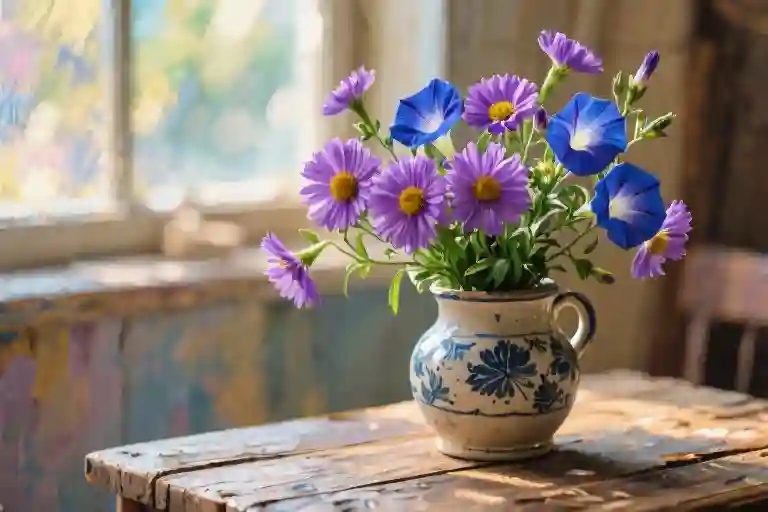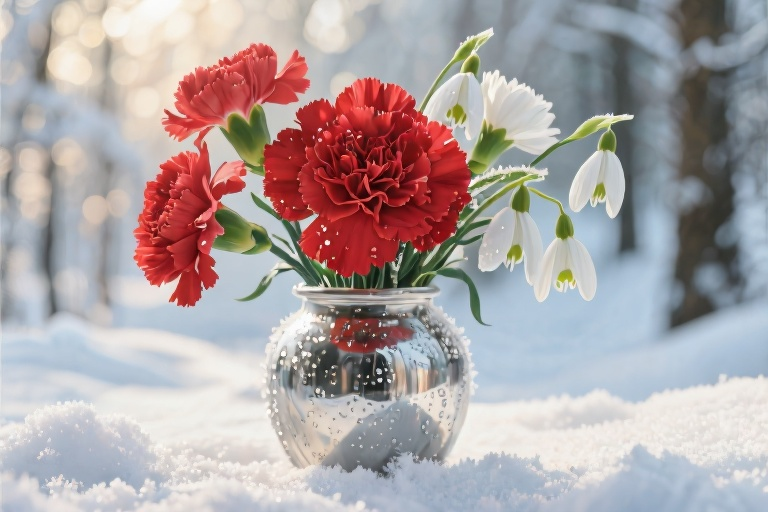Most people reaching for birthday flowers in September instinctively grab chrysanthemums or dahlias, unaware they’re overlooking two botanical gems with far richer stories. The September birth flowers—asters and morning glories—form an unexpected duo where starburst blooms meet ephemeral trumpets, each carrying distinct whispers from horticultural history.
What makes this pairing fascinating isn’t just their contrasting personalities (one steadfast as constellations, the other fleeting as dawn), but how they’ve traveled through centuries of human imagination. Greek shepherds once scattered aster petals to ward off evil spirits, while Edo-period poets in Japan composed thousands of haiku about morning glories’ daily resurrection.
That 85% of gift-givers don’t know about these dual September birth flowers seems almost poetic—like keeping a celestial secret. The aster’s dense clusters of lavender rays have decorated Victorian sympathy cards and NASA experiment modules alike, proving their versatility beyond simple bouquets. Meanwhile, morning glories perform their daily miracle, unfurling new cobalt-blue blossoms every sunrise as reliably as they did when Monet painted them in 1883.
There’s quiet drama in how these plants intersect with human rituals. Brides carrying asters in medieval Europe believed the star-shaped flowers would bless their marriages with cosmic harmony. Modern urban gardeners train morning glory vines up fire escapes, creating living curtains that filter morning light through heart-shaped leaves. Both species share an unshowy resilience—asters thriving in rocky alpine soils, morning glories self-seeding through sidewalk cracks—that makes them unexpectedly profound metaphors for September birthdays marking summer’s surrender to autumn.
The Celestial and the Ephemeral: A Tale of Two September Blooms
September birthdays carry a botanical secret – not one, but two floral ambassadors that couldn’t be more different in character. The aster stands grounded with its starburst petals, while the morning glory performs its daily disappearing act with sunrise precision. These aren’t just flowers; they’re nature’s poetry in motion.
Aster whispers of cosmic connections. Its very name derives from the Ancient Greek word for ‘star’, a fitting tribute to the way its slender petals radiate from a golden center like miniature supernovas. Victorian gardeners prized the Michaelmas daisy (a type of aster) as autumn’s last floral hurrah, its purple varieties blooming defiantly as summer surrendered to fall. Modern cultivars now offer a celestial color palette – from the pale ‘Moonlight’ variety to the deep cosmic purple of ‘Royal Ruby’.
Meanwhile, morning glory operates on an entirely different rhythm. These trumpet-shaped charmers unfurl their satiny petals at dawn, only to retreat by afternoon in what the Japanese call ‘asagao’ (morning face). The ‘Heavenly Blue’ variety seems to capture fragments of the morning sky in its petals, while ‘Scarlet O’Hara’ lives up to its dramatic name with vibrant crimson blooms. Their twining vines carry an air of spontaneity, often surprising gardeners with unexpected volunteers from last year’s dropped seeds.
What makes this floral pairing remarkable isn’t just their contrasting forms – the aster’s sturdy, multi-branched structure versus the morning glory’s delicate annual vines – but their complementary symbolism. One represents endurance (asters can persist through early frosts), the other celebrates fleeting beauty. Together, they form a complete philosophy: the importance of both permanence and presence.
For those seeking to identify these September birth flowers in the wild or garden:
- Aster markers: Look for daisy-like flowers with 20-30 thin petals surrounding a prominent yellow disk. Leaves are lance-shaped with toothed edges.
- Morning glory tells: Heart-shaped leaves and spiraling vines that cling to supports. Flowers have five fused petals forming that distinctive trumpet shape, often with star-patterned throats.
These botanical bookends of September – one rooted in earth’s cycles, the other dancing with the sun – offer more than just decorative appeal. They’re living reminders that birthday celebrations, much like gardens, thrive on diversity and contrast.
The Timeless Language in Petals
Few things carry whispers of history quite like flowers. The September birth flowers, asters and morning glories, hold particularly poignant stories in their delicate forms. These aren’t just botanical specimens – they’re living artifacts of human emotion, carrying meanings that have transcended centuries and continents.
Asters earned their warrior’s reputation during ancient Greek battles. Soldiers would tuck these starry blooms into their armor, believing the flowers could deflect arrows and bring victory. The practice wasn’t entirely superstition – the aster’s dense clusters actually did help cushion blows. Today, we’ve traded battlefields for birthday parties, but that protective symbolism remains. When you gift purple asters, you’re unconsciously continuing a tradition that began with Spartan warriors wielding swords instead of cake forks.
Morning glories tell a gentler story through Japanese literature. The Manyoshu, compiled over 1,200 years ago, contains numerous poems comparing these fleeting blooms to passionate love. Their brief morning brilliance became a metaphor for intense but transient relationships. Contemporary florists might not realize it, but when they arrange morning glories for September weddings, they’re echoing sentiments first expressed by eighth-century poets observing dew-kissed vines at dawn.
What’s remarkable is how these floral meanings have adapted without losing their essence. Victorian flower dictionaries assigned asters the meaning of ‘patience’ – perhaps a nod to their late summer perseverance when other flowers fade. Modern interpretations lean into their star shape, suggesting cosmic connections and infinite possibilities. Morning glories kept their association with affection but gained new layers; their daily rebirth now symbolizes renewal and second chances.
The real magic happens when these histories intersect with personal moments. That aster in a birthday bouquet? It’s carrying wishes older than Shakespeare. The morning glory vine twining around a porch rail? It’s reenacting botanical dramas observed by emperors and peasants alike. These September flowers don’t just grow – they remember, they signify, they connect us to everyone who ever paused to wonder at a petal’s curve or a blossom’s brief, perfect morning.
From Windowsill to Garden: A Grower’s Guide
Gardening should feel like a conversation with nature, not a battle against it. For September birth flower enthusiasts, cultivating asters and morning glories offers distinct joys and challenges. These botanical companions demand different approaches – one thrives with methodical care, the other rewards spontaneous bursts of attention.
For balcony gardeners, the dwarf aster ‘Pixie Dark’ proves particularly accommodating. Its compact 12-inch stature conceals remarkable resilience. I’ve watched these purple dynamos flourish in conditions that would wilt more delicate varieties. The secret lies in their Mediterranean ancestry – they prefer their roots like their native soil: well-drained and slightly neglected. A terracotta pot with extra perlite mixed into standard potting soil creates the perfect microclimate. Water only when the top inch of soil becomes dry to the touch; overzealous hydration leads to the dreaded root rot that claims many beginner’s plants.
Morning glories, those ephemeral trumpeters of dawn, require a different mindset. Their reputation as ‘easy’ growers hides three common pitfalls. First, the seeds – those hard, pebble-like capsules – benefit from overnight soaking or gentle scarification with sandpaper. I learned this the hard way after waiting weeks for untreated seeds to sprout. Second, their twining vines crave immediate support. Install trellises or strings at planting time; playing catch-up with established vines leads to broken stems. Lastly, that glorious daily flowering comes at a price – they’re thirsty plants. Container-grown specimens need daily watering during peak summer, preferably in the cool of early morning when their blooms are open to receive it.
Light becomes the deciding factor in urban settings. Asters demand a minimum of six direct sunlight hours – a south-facing windowsill often suffices. Morning glories perform their namesake magic best with eastern exposure, where first light coaxes open their spiraled petals. In my Brooklyn fire escape garden, I’ve found success training them along the railings where they catch sunrise while the asters bask in afternoon rays.
The payoff comes in September when these plants reveal their true purpose. ‘Pixie Dark’ erupts in hundreds of quarter-sized flowers just as other perennials fade. Morning glories, having scaled their trellises all summer, produce daily cascades of color. Their synchronized performance – one greeting the day, the other shining through twilight – creates a living celebration of birth month magic.
Creative Ways to Let Flowers Speak for You
Flowers have always been messengers of emotion, but for September birthdays, we get to work with nature’s own dynamic duo – the starry asters and morning’s first trumpet call of glory blooms. These two flowers offer more possibilities than the standard bouquet, especially when you’re looking to create something truly memorable.
The Edible Morning Glory Cocktail Surprise
Morning glories aren’t just for trellises anymore. Their vibrant colors translate beautifully into culinary creations, particularly when frozen into ice spheres for birthday cocktails. The process is simpler than you might think:
- Harvest fresh morning glory blooms in the early hours (their colors are most intense before noon)
- Gently rinse and pat dry, removing any green parts
- Arrange inside ice cube trays or sphere molds
- Pour filtered water or clear juice (white grape works well) over the flowers
- Freeze for at least 6 hours
When dropped into a glass of champagne or gin tonic, these floral ice balls slowly release their captive blooms as they melt – a living metaphor for the unfolding joy of a birthday celebration. For September babies who prefer non-alcoholic options, try floating the ice spheres in sparkling elderflower pressé.
The #DualBloom Social Media Challenge
Social platforms have given flower lovers new ways to connect, and September’s birth flowers present unique opportunities. The #DualBloom challenge encourages participants to:
- Capture asters and morning glories in the same frame (tricky given their different active hours)
- Create art pieces combining their contrasting shapes
- Share personal stories connecting to either flower’s symbolism
What makes this trend particularly engaging is how it plays with contrasts – the dayflower versus the all-day bloomer, the celestial shape against the earthly trumpet. Some participants have taken to photographing asters under moonlight and morning glories at dawn, then merging the images digitally for stunning diptychs.
For those seeking more hands-on engagement, try the “Birth Month Bloom” variation – arranging September flowers with the recipient’s birth month blooms in a single composition. The combinations can yield surprising harmonies, like the soft pinks of June roses playing against aster’s deeper purples.
These creative applications do more than just showcase floral beauty – they extend the conversation about what birthday flowers can represent. A morning glory cocktail isn’t just a drink, but a nod to embracing life’s fleeting moments. A social media challenge becomes a way to connect across time zones through shared appreciation of nature’s designs. The true gift lies not in the flowers themselves, but in the new perspectives they help cultivate.
A Final Floral Note
As we close this exploration of September’s birth flowers, consider this: the aster and morning glory aren’t just botanical specimens—they’re living metaphors. One mirrors the steadfast glow of stars, the other dances with the sun’s first light. Their duality makes them perfect companions, much like the balance we seek in life.
For those who crave a deeper connection, follow NASA’s ongoing aster cultivation experiments aboard the International Space Station. Watching these resilient blooms thrive in zero gravity might just change your perspective on what it means to grow.
And because every celebration deserves a personal touch, we’re offering limited-time access to our September Birth Flower Digital Card Collection. These customizable templates feature vintage botanical illustrations of asters and morning glories—ready to adorn your messages with a whisper of floral magic. Claim yours before the next equinox, and let petals do the talking.
So tell us—will you plant these September symbols in your garden, or press them between the pages of someone’s story? Either way, may your days bloom with the quiet wonder of asters and the joyful urgency of morning glories.




